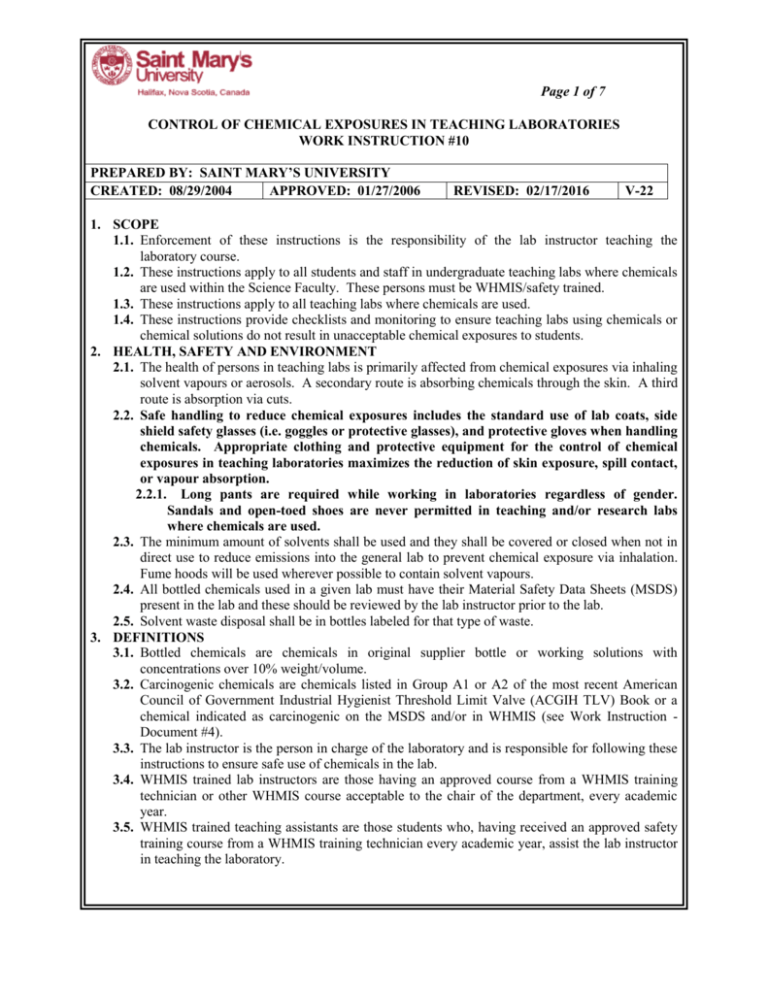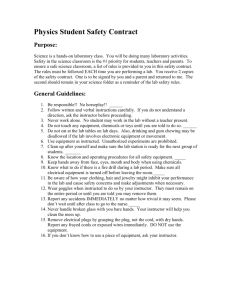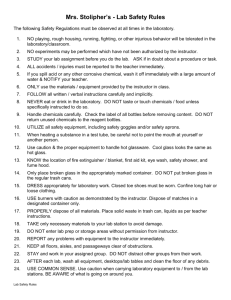Document #: - Saint Mary`s University
advertisement

Page 1 of 7
CONTROL OF CHEMICAL EXPOSURES IN TEACHING LABORATORIES
WORK INSTRUCTION #10
PREPARED BY: SAINT MARY’S UNIVERSITY
CREATED: 08/29/2004
APPROVED: 01/27/2006
REVISED: 02/17/2016
V-22
1. SCOPE
1.1. Enforcement of these instructions is the responsibility of the lab instructor teaching the
laboratory course.
1.2. These instructions apply to all students and staff in undergraduate teaching labs where chemicals
are used within the Science Faculty. These persons must be WHMIS/safety trained.
1.3. These instructions apply to all teaching labs where chemicals are used.
1.4. These instructions provide checklists and monitoring to ensure teaching labs using chemicals or
chemical solutions do not result in unacceptable chemical exposures to students.
2. HEALTH, SAFETY AND ENVIRONMENT
2.1. The health of persons in teaching labs is primarily affected from chemical exposures via inhaling
solvent vapours or aerosols. A secondary route is absorbing chemicals through the skin. A third
route is absorption via cuts.
2.2. Safe handling to reduce chemical exposures includes the standard use of lab coats, side
shield safety glasses (i.e. goggles or protective glasses), and protective gloves when handling
chemicals. Appropriate clothing and protective equipment for the control of chemical
exposures in teaching laboratories maximizes the reduction of skin exposure, spill contact,
or vapour absorption.
2.2.1. Long pants are required while working in laboratories regardless of gender.
Sandals and open-toed shoes are never permitted in teaching and/or research labs
where chemicals are used.
2.3. The minimum amount of solvents shall be used and they shall be covered or closed when not in
direct use to reduce emissions into the general lab to prevent chemical exposure via inhalation.
Fume hoods will be used wherever possible to contain solvent vapours.
2.4. All bottled chemicals used in a given lab must have their Material Safety Data Sheets (MSDS)
present in the lab and these should be reviewed by the lab instructor prior to the lab.
2.5. Solvent waste disposal shall be in bottles labeled for that type of waste.
3. DEFINITIONS
3.1. Bottled chemicals are chemicals in original supplier bottle or working solutions with
concentrations over 10% weight/volume.
3.2. Carcinogenic chemicals are chemicals listed in Group A1 or A2 of the most recent American
Council of Government Industrial Hygienist Threshold Limit Valve (ACGIH TLV) Book or a
chemical indicated as carcinogenic on the MSDS and/or in WHMIS (see Work Instruction Document #4).
3.3. The lab instructor is the person in charge of the laboratory and is responsible for following these
instructions to ensure safe use of chemicals in the lab.
3.4. WHMIS trained lab instructors are those having an approved course from a WHMIS training
technician or other WHMIS course acceptable to the chair of the department, every academic
year.
3.5. WHMIS trained teaching assistants are those students who, having received an approved safety
training course from a WHMIS training technician every academic year, assist the lab instructor
in teaching the laboratory.
Page 2 of 7
CONTROL OF CHEMICAL EXPOSURES IN TEACHING LABORATORIES
WORK INSTRUCTION #10
PREPARED BY: SAINT MARY’S UNIVERSITY
CREATED: 08/29/2004
APPROVED: 01/27/2006
REVISED: 02/17/2016
V-22
4. SAFETY EQUIPMENT AND SUPPLIES
4.1. Safety Equipment to Control Exposures
4.1.1. All installed HVAC equipment (i.e. general [Heating, Ventilation, and Air Conditioning
{HVAC}], and vapour scrubbers, and fume hoods where present) shall be operating for at
least 10 minutes before the first solvent is opened and for at least 10 minutes after the last
solvent is closed.
4.1.2. All eyewash stations, fire extinguishers and first aid boxes shall have an authorized tag
showing they have been inspected in the appropriate time interval and have passed.
4.1.3. All personal protective equipment specified in 2.2 shall be worn from start to finish of the
lab unless otherwise specified by the lab instructor. In this case, the lab instructor shall
ensure that no hazardous chemicals capable of coming in contact with skin or eyes are
present. MSDS shall be consulted prior to any decision to not use protective equipment.
4.1.4. Solvent wastes shall be disposed of via the appropriately labeled waste bottles. Further
information is available through the Work Instruction #13.
4.2. Safety Equipment to Monitor Exposures
4.2.1. A dosimeter tube, appropriate to the volatile chemical, shall be placed either on a student
working in the middle of the lab or on the bench top near the working location of the lab
instructor.
5. PROCEDURE
5.1. Pre-Lab
5.1.1. All students shall have a copy of the lab being taught that day and be instructed to read
the lab instructions before coming to the class.
5.1.2. All students shall have necessary safety equipment and be wearing it as specified in 2.2.
5.1.3. Students shall have the hazards of this lab reviewed with them before starting the lab
including information on exposure route and health effects (inhalation, absorption, and
acute/chronic effects), and exposure control actions (minimum chemical use, cover
chemicals when not in use, personal protective equipment, etc.).
5.1.4. The lab area must be clean and no unauthorized materials are to be in the lab (i.e. food,
drink, earphones, operating cell phones).
5.1.5. Pre-lab safety shall be confirmed by the lab instructor completing and initialing all
relevant entries in Part 1 of the checklist provided in Form 10.1.
5.1.6. Where labs intend to use potentially carcinogenic or hazardous chemicals (See 3.2), Form
6.1 – Hazardous Chemical Use Risk Assessment and Form 6.2 – Control Options
Assessment must be completed and signed by the chair and the Dean of Science or their
appropriate designate.
5.1.7. If a Form 10.1 shall be posted in the lab in a visible location as evidence that the lab is in
a safe status.
5.2. During Lab
5.2.1. The lab shall be carried out as specified in the written lab instructions presented by the
lab instructor. Any variances must be given by the lab instructor in writing (using a
blackboard/paper) and explained to students and TAs prior to or during the lab, and a copy
attached to the Form 10.1.
Page 3 of 7
CONTROL OF CHEMICAL EXPOSURES IN TEACHING LABORATORIES
WORK INSTRUCTION #10
PREPARED BY: SAINT MARY’S UNIVERSITY
CREATED: 08/29/2004
APPROVED: 01/27/2006
5.2.2.
REVISED: 02/17/2016
V-22
Any chemicals synthesized (and that may be needed in the future) must be labeled with a
WHMIS workplace label.
5.2.3. Any unplanned unsafe conditions that occur and errors in interpreting lab instructions
shall be documented by the lab instructor, a copy attached to Form 10.1 and reported to the
preparer of the lab (if not the lab instructor).
5.2.4. During the lab any spills, near misses, minor or major injuries or those requiring medical
attention must be documented by the lab instructor on the Saint Mary’s Injury/Incident
Report. A copy of this form shall be attached to Form 10.1.
5.2.5. The presence of any pronounced odours in the lab and the most probable source should
be documented by the lab instructor in the comment section of Form 10.1.
5.3. Post-Lab
5.3.1. The lab instructor shall confirm that all incidents including near misses and unplanned
unsafe conditions have been documented on the Saint Mary’s Injury/Incident Report and
attached to Form 10.1.
5.3.2. The lab instructor shall confirm all waste chemicals have been properly collected and
secured.
5.3.3. The lab instructor shall confirm all unused chemicals have been returned to their original
location or left for technicians to put away by prior arrangement.
5.3.4. The lab instructor shall record the length of the lab (time students present), read the
dositube, and calculate average exposure (TWA) over the lab period in ppm. If this exceeds
the TLV as specified in the most recent ACGIH TLV Handbook, the lab instructor shall
inform in writing to the Dean of Science, the Director of the Facilities Management
Department and the Occupational Health and Safety Program Manager. They shall
undertake necessary remedial action. If the remedial action is not sufficient and the TLV is
exceeded for a second time, then the lab shall be discontinued until such time that a
qualified authority can advise on remedial action and confirm its effectiveness.
6. FORMS
6.1. Form 10.1 shall be completed and signed by the laboratory instructor. Check marks or other
ambiguous marks should not be used by the person completing the form.
6.2. Part 1 is divided in to Sections A and B. Section A only need be completed by the lab instructor
if no bottled chemicals (see definition) are being used in the lab. Section B additionally must be
completed by the lab instructor if bottled chemicals (see definitions) are being used.
6.3. Once Sections A and B as appropriate are completed the lab instructor shall sign at the end of
Part 1 and file the sheet.
6.4. Parts 2 and 3 of the form shall be completed prior to the lab instructor leaving the lab. If upon
completion Part 3 is not acceptable, the lab instructor shall resolve the problem prior to the next
lab in that room (he/she may summon assistance as required to resolve the situation), and shall
inform their chair.
6.5. Failures to meet acceptance shall be copied immediately to the chair of the department for their
input.
6.6. The original of the form shall be held in the Science Faculty by the lab instructor responsible for
the lab.
Page 4 of 7
CONTROL OF CHEMICAL EXPOSURES IN TEACHING LABORATORIES
WORK INSTRUCTION #10
PREPARED BY: SAINT MARY’S UNIVERSITY
CREATED: 08/29/2004
APPROVED: 01/27/2006
REVISED: 02/17/2016
V-22
6.7. At the end of the semester, the lab instructor shall report in writing to his/her chair, any
acceptance conditions that were not met and document any incidents (i.e. number of near misses,
minor spills, Injury/Incident Reports issued, etc.). If acceptance conditions were met for all labs,
the instructor shall also inform the chair of this in writing.
Page 5 of 7
CONTROL OF CHEMICAL EXPOSURES IN TEACHING LABORATORIES
WORK INSTRUCTION #10
PREPARED BY: SAINT MARY’S UNIVERSITY
CREATED: 08/29/2004
APPROVED: 01/27/2006
REVISED: 02/17/2016
V-22
FORM 10.1
Course Title, No., and Section
Lab Instructor
(please print)
Location
(Faculty, Rm. #)
PART 1: PRE-LAB
Section A
MONITORED PARAMETER
Lab Title
Date
INSPECTOR
INITIALS *
1
General HVAC fan on.
PLEASE
CIRCLE
YES | NO
2
Fire extinguisher present.
YES | NO
3
Eyewash station present.
YES | NO
4
First aid kit present.
YES | NO
5
All students have copy of lab
procedures or have been
instructed to download from the
web and have been instructed to
read.
Section A is acceptable, lab instructor sign.
YES | NO
Section B - Are bottled chemicals or solutions of hazardous
chemicals over 10% weight/volume in use?
6
Are any of these chemicals
known to be carcinogenic? (See
3.2) If yes, complete Form 6.1
and Form 6.2.
7
Fume hoods, where present, fan
on.
8
Vapour scrubber units fan on or
not required (NR).
9A Students wear glasses.
COMMENTS
If yes, complete 7 to 23.
YES | NO
YES | NO
YES | NR
YES | NO
9B
Students wear lab coats.
YES | NO
10
Gloves present and required or
YES | NR
Page 6 of 7
CONTROL OF CHEMICAL EXPOSURES IN TEACHING LABORATORIES
WORK INSTRUCTION #10
PREPARED BY: SAINT MARY’S UNIVERSITY
CREATED: 08/29/2004
APPROVED: 01/27/2006
REVISED: 02/17/2016
not required (NR) by lab
instructor.
11
Instructor has current (within
YES | NO
past three years) MSDS for
bottled chemicals used. (See
2.4)
12
Appropriate & sufficient labeled
YES | NO
waste bottles present.
13
Appropriate dositube started
YES | NO
(note time and tube #).
Sections A and B acceptable lab can start, lab instructor sign.
PART 2: DURING LAB
14
Lab procedures reviewed with
students. This includes
identification of hazards and
control of chemical exposures.
15
Variance issued. Describe.
16
YES | NO
NONE
All solvents covered or sealed
when not in use.
Unexpected unsafe conditions.
Describe.
YES | NO
18
Minor lab spills or near misses.
Describe.
NONE
19
Reportable incidents or spills.
(See 5.2.4)
Complete Saint
Mary’s Incident/Injury Report.
Pronounced odour in lab.
NONE
17
20
PART 3: POST LAB
21
All waste solvents in appropriate
labeled bottles.
22
All unused chemicals back in
original location or left by prior
NONE
NONE
YES | NO
YES | NO
V-22
Page 7 of 7
CONTROL OF CHEMICAL EXPOSURES IN TEACHING LABORATORIES
WORK INSTRUCTION #10
PREPARED BY: SAINT MARY’S UNIVERSITY
CREATED: 08/29/2004
APPROVED: 01/27/2006
23
arrangement.
Dositube reading (note time,
raw reading, etc.)
REVISED: 02/17/2016
V-22
YES | NO
Parts 2 and 3 acceptable, lab instructor sign.
GENERAL COMMENTS
Lab instructors must maintain the completed form in their Science Faculty files until the end of the
semester. At the end of the semester, the forms should be submitted to the chair/program co-ordinator
with a summary. (See 6.7).








